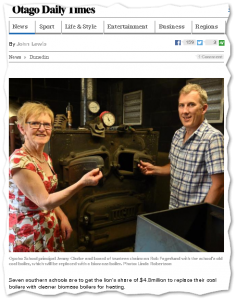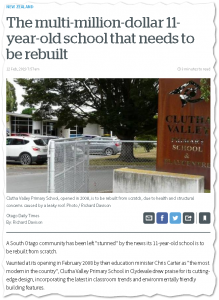
Replacing eight schools’ coal-fired boilers with ones that run on biomass, as reported earlier this year, is a good move but it wouldn’t be necessary if our schools weren’t built so badly.
Too many students are herded into poorly-designed, badly-constructed school buildings that can create an unhealthy learning environment. They take huge amounts of energy to run and may still be far too hot or cold to be comfortable for students and teachers.
In the past couple of years, I’ve been asked to consult architects and school boards about problem buildings and provided recommendations for how to remediate issues with internal moisture and massive overheating.
The extent of the problems that are arising—especially in recently built school buildings—is intensely frustrating. The internal temperature inside a school building should stay comfortable no matter what the weather outside. The technology exists to achieve that while using hardly any energy for heating or cooling.
These buildings that house our kids for six or eight hours a day also need to be properly ventilated, so the air is fresh and free from outside pollutants or irritants. Mechanical ventilation also helps ensure that classrooms aren’t damp, with all the problems that create—for student health and the integrity of building materials.
I’ve investigated schools that “rain” inside on sunny days because of poor roof design that creates intense condensation in the ceiling.


Taihape Area School was only 10 years old when it was condemned last year because of issues with weather tightness. It was a similar story at Clutha Valley Primary School in Otago. The intense focus on lowering the first costs to build, at the expense of quality, durability and functionality, is simply stupid especially when these are public buildings that house an essential service.
There is simply no reason to not design extremely energy-efficient school buildings. The government is spending taxpayer money to both build schools and pay their ongoing running costs. The extra first cost to design a large building like a school to Passive House standard is minimal and will be quickly balanced by the ongoing savings on heating and cooling.
Plus it delivers a host of other benefits, including better quality, more durable building components, fresher air, stable indoor temperature and a quieter classroom due to double or triple glazing.
Several hundred Passive House kindergartens and schools have been built overseas, as well as supermarkets, office buildings, museums and hospitals.
We absolutely need to expect more from new school buildings. There is also a strong social and business rationale for retrofitting existing schools so that they use less energy, emit less carbon and provide healthier learning environments.”
The government is talking about ‘decarbonising’ public assets. Our schools are a good place to start.
—16 April 2020
Comments 1
Thanks Jason, your argument is correct, I look forward to the day when designing/building well will not be looked on with suspicion of the designers/builders intent to make a higher margin but with the knowledge that this is the best long term cost saving solution… not to mention the health & comfort benefits!